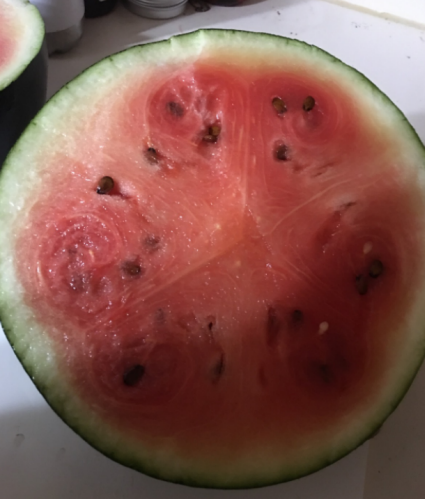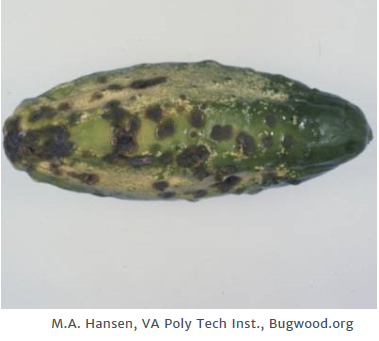Click on the link below to listen to my 2 min. Garden Bite radio show: Virus and Fungal spots on fruit – can I eat that?
Last week I told you about my listener with watermelon mosaic virus,

this type of virus and others like it, can create some pretty weird things on squash and melons including funky fungal growths, sunken spots and scabs. The question becomes, can you eat that fruit? For my listener, Sandee, who has the WMV…. she sent pics, and yes, you can eat that fruit.

The University of Minnesota says…yes, mostly… These viruses are not harmful to humans and don’t cause the fruit to rot. Often the discoloration is only skin deep. As you can see above, the inside was not affected. Sandee said it was “slightly sweeter”… the inside had a tinge of orange.
However, in cases where fruit are severely distorted, the texture of the fruit may be affected and may not be desirable for eating. Additionally, there are several different fungi that cause fruit rot in squash and melon. Scab and anthracnose are common in the Upper Midwest. Click on those links for much more information and pictures of the diseases.

 Both of these diseases start as a leaf spot disease and eventually infect fruit. In some cases you can cut out the rotten spots and eat it, others may be too far gone.
Both of these diseases start as a leaf spot disease and eventually infect fruit. In some cases you can cut out the rotten spots and eat it, others may be too far gone.
The type of spot that occurs on the fruit depends on which disease is present and how susceptible or resistant the plant is.
Anthracnose causes sunken round spots in the fruit of cucumber, squash, and melons. If moisture is present, fluffy fungal growth and powdery salmon colored spores can be seen within the fruit spot.
Scab causes sunken round spots on cucumber, summer squash, and pumpkin that may be covered with a dark green to black velvety fungal growth when humidity is high.
Some types of winter squash are moderately resistant to scab and will develop a raised corky bump on the fruit instead of a sunken spot. Resistant varieties are available for scab and anthracnose in some crops. The link takes you to Cornell University Veg. MD. You may want to just download the type of fruit/vegetable you’re looking for – it’s pretty extensive!
